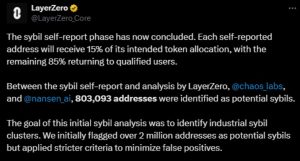As deepfakes, bots, and AI-generated content flood the internet, several projects are developing solutions to tackle this growing problem. Bots and fake users are rampant across platforms like X (formerly Twitter), Facebook, and even online games, causing issues such as manipulating crypto airdrops.
A recent study estimates that between 5% and 15% of X accounts are bots, while Facebook regularly bans hundreds of millions of fake users. Crypto games are also affected, with bots faking activity to qualify for rewards like airdrops.
Identifying bots can sometimes be simple due to repetitive behavior or errors, but advances in AI make it increasingly hard to distinguish real users from fake ones. A study from the University of Waterloo found that only 61% of participants could correctly identify AI-generated images from real ones, much lower than the 85% expected.
Blockchain to Verify Humanity
Several blockchain projects are tackling this issue by creating digital ID systems to confirm the authenticity of users. Shady El Damaty, co-founder of blockchain-based identity platform Holonym, explained that their system, “human keys,” uses personal attributes like biometrics or passwords to verify real people.
Another project, Civic, uses video verification to confirm a user’s authenticity. Civic’s vice president, Titus Capilnean, noted that document verification adds extra friction but is sometimes necessary to ensure legitimacy.
Other blockchain projects like Proof of Humanity and World coin’s iris-scanning Orbs are also exploring ways to verify users, though privacy concerns about biometric data persist. Holonym addresses these concerns by keeping most of the data on users’ devices and requiring consent before sharing any sensitive information.
Use of Digital ID in the Real World
Digital ID systems have already shown their potential. For example, in May, the blockchain protocol LayerZero used anti-Sybil measures to eliminate bots attempting to claim airdrop tokens dishonestly. This resulted in better token performance compared to projects that gave tokens to bots, which were quickly sold for profit.

Blockchain-based digital ID systems also have broader applications beyond crypto. During Andrew Yang’s 2020 U.S. presidential campaign, Holonym allowed anonymous donors to contribute while verifying their U.S. residency using zero-knowledge technology, ensuring compliance with election laws.
Future Potential for Blockchain-Based IDs
Digital ID systems are not just for fighting bots and securing airdrops—they have the potential to address global challenges. Holonym is working on a project to help Rohingya refugees in Myanmar gain access to banking and financial services through proof-of-humanity technology. This effort, in collaboration with organizations like the UN and Refugee Fund, aims to provide displaced people with legal credentials to access essential services.
Conclusion
Blockchain-based digital ID systems offer promising solutions to the challenges posed by AI-generated content and bots. These systems not only help ensure fairness in crypto airdrops but could also play a vital role in political processes and humanitarian efforts, providing a secure way to verify individuals while protecting their privacy.
Source: https://cointelegraph.com/news/blockchain-ai-fakes-crypto-airdrops-elections
___________________
Disclaimer: “The articles on this website reflect the opinions of the respective writers and are not the opinion of Museigen.io. In addition, nothing in this article should be considered as financial advice. It is essential to conduct your independent research and consult with a qualified financial advisor before making any financial decisions.”


